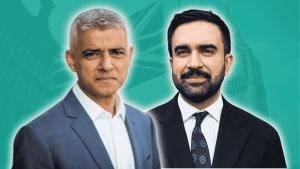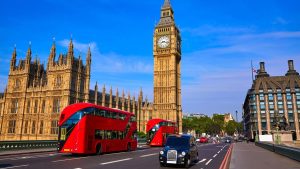Two of the world’s most iconic and influential cities – New York City (USA) and London (UK) both feature mayors whose roles command global attention.
But the scope of their powers differs significantly. Below is a detailed comparison of each mayoralty: the formal authorities, real-world constraints, and key take-aways for how city leadership truly works.
The Mayor of New York City
Zohran Mamdani (mayor‐elect, takes office Jan 1 2026)

Key facts & historical note
- Zohran Mamdani, at age 34, became the mayor-elect of New York City in November 2025.
- He is the first Muslim and first South Asian heritage person to win the office in NYC.
- Mamdani ran on a progressive platform emphasising housing affordability, universal childcare, free buses, and raising the minimum wage.
Powers & responsibilities
The mayor of New York City is among the most powerful municipal executives in the world. Some of the key dimensions:
- The mayor is the chief executive of the city government, with responsibility for city services, agencies, public property, and enforcing city/state law within NYC.
- Budgetary authority: The mayor prepares and manages the annual budget for the city, including the largest municipal budget in the US (exceeding US$100 billion) and oversees a vast workforce.
- Appointment power: The mayor appoints commissioners, heads of departments, deputy mayors, and shapes the agencies that deliver services.
- Legislative influence: While the mayor cannot unilaterally create laws, they sign or veto legislation passed by the City Council.
- Control over many city functions: The mayor oversees transit, housing, education (in NYC’s case the mayor appoints the chancellor of the NYC Department of Education), public safety, sanitation, etc.
Real-world constraints
Even with strong formal powers, there are important limits to the mayor’s influence:
- Tax increases: The mayor may propose tax changes, but major increases often require approval from the state legislature (e.g., New York State Legislature) and governor. The city cannot unilaterally raise many taxes.
- State and federal dependencies: The city receives substantial funding and must comply with state/federal laws. Some policies (e.g., transit fare regulation, major infrastructure) involve state agencies.
- Political, institutional and resource constraints: The mayor must negotiate with the City Council, boroughs, agencies, and other stakeholders.
Implications for NYC’s mayoral power
- In effect, NYC’s mayor is a powerful executive: all five boroughs, huge budget, direct control of agencies and services.
- The mayor’s role combines operational management (running the city) + political leadership (agenda-setting).
- Because of the scale of NYC, the mayor’s decisions reverberate nationally and internationally.
- But success still depends on navigating state law, funding sources, the City Council, and unions/interest groups.
The Mayor of London
Sadiq Khan (current Mayor)

Key facts & historical note
- The Mayor of London is the directly elected head of the Greater London Authority (GLA).
- Election cycle: Every four years, voters across London elect the mayor.
- Powers are derived from legislation including the Greater London Authority Act 1999, as amended.
Powers & responsibilities
The London mayor holds a strategic role rather than full executive control of all services; key powers include:
- Strategic planning: The mayor develops the “London Plan” which sets city‐wide planning and development policy (housing, environment, waste, spatial strategy).
- Transport: The mayor directs the functional body Transport for London (TfL) which manages the Tube, buses, roads, and related infrastructure.
- Policing & crime strategy: The mayor has oversight of policing priorities through the Mayor’s Office for Policing & Crime (MOPAC) and sets strategic aims for the Metropolitan Police Service.
- Environment & housing strategy: While actual delivery often lies with boroughs, the mayor sets strategic initiatives and policies for housing supply, affordability, and environmental standards.
- Budget & resource setting: The mayor proposes the GLA budget and determines how the GLA’s funds are allocated to the strategic functions.
Significant constraints & shared power
- Many local services (education, social care, local planning enforcement, borough roads, local social services) remain the responsibility of London’s 33 borough councils, not the mayor.
- Major tax-raising powers are limited: While the mayor has some powers (e.g., certain precepts in council tax, maybe parts of business rates), many taxation powers remain with UK Government or boroughs.
- Delivery vs strategy: The mayor often sets strategy and targets, but relies on boroughs, external agencies, or private partners for delivery and enforcement.
- Scrutiny and checks: The London Assembly oversees and scrutinises the mayor’s actions and budget.
Implications for London’s mayoral power
- The Mayor of London is a strategic city-wide leader: sets vision, big picture policy, transport and policing oversight, housing strategy.
- The role is less operationally granular than NYC’s: boroughs retain many direct delivery functions.
- The mayor must collaborate significantly with national government, boroughs, and agencies.
- Because of this structure, the London mayor’s influence often lies in agenda-setting, advocacy, coordination, and leveraging transport/housing as levers rather than full command over all services.
Direct Comparison: NYC vs London
| Feature | NYC Mayor | London Mayor |
|---|---|---|
| Operational scope | Broad executive control of many city services (education, housing, transit, public safety, sanitation) via mayoral office. | Strategic control (transport, policing, planning) but delivery often via boroughs; schools/social services largely not under direct mayor control. |
| Budget size | Very large; mayor proposes and manages a multi-billion dollar budget covering all five boroughs. | The mayor controls GLA’s budget (~£20 billion+) for strategic functions but many services remain elsewhere. |
| Taxation & raising revenue | Proposes budget, but many tax decisions require state approval; strong but constrained. | More limited tax-raising; many powers reserved for national government or boroughs. |
| Appointment power | Mayor appoints heads of city agencies, department commissioners, strong administrative leverage. | Mayor appoints certain strategic roles (transport, policing leadership) but many local officers are appointed at borough or national level. |
| Local government fragmentation | Single city government for all boroughs (five boroughs unified under one mayor/city hall) | Many functions devolved: 33 boroughs have councils with substantial power; mayor oversees but does not absorb all. |
| Accountability & scrutiny | Mayor held accountable via citywide election; city council oversight; state & federal oversight too. | Mayor held accountable via London-wide election; London Assembly provides scrutiny; national government oversight as well. |
| Global role & visibility | Mayor of NYC is a major figure internationally for business, climate, culture, urban policy. | Mayor of London likewise has global profile, especially in transport, housing, climate and as a major global city. |
| Typical strength | Strong “mayor‐executive” model | Strong “strategic mayor” model |
In short: NYC’s mayor ≈ powerful executive running much of the city’s machinery, whereas London’s mayor ≈ strategic leader shaping policy, transport & policing, but sharing/delivering many services through other levels.
Why It Matters: For Urban Governance and Beyond
- City leadership shapes global influence: Both NYC and London mayors act as international ambassadors for their cities – in business, climate, culture, migration, and urban innovation.
- Policy scope is tied to institutional design: The extent of mayoral power depends on how the city’s government is structured, what functions are devolved, and what laws apply.
- Budget + bureaucracy = real power: Controlling large budgets and managing large workforces gives the mayor influence over what gets done (and how).
- Collaboration remains essential: Even a strong mayor depends on other levels of government (state, national), stakeholders (boroughs, agencies, communities), and institutional constraints.
- Symbolism matters: A mayor’s platform and rhetoric can shape national politics (especially in the US) and global urban agendas (transport, climate, housing). For example, Mamdani’s win in NYC has been remarked upon as a progressive shift.
Looking Ahead: Challenges & Opportunities for Each
For NYC / Mamdani:
- Translating ambitious campaign promises (free buses, rent freezes, universal childcare) into reality – given legal/financial constraints.
- Managing a massive bureaucracy, large budget, and coordinating across agencies and boroughs.
- Negotiating with New York State and federal government for funding or legal authority.
- Maintaining political support and delivering tangible results to justify the historic mandate.
For London / Khan (and future mayors):
- Delivering consistent results in areas within mayoral remit (transport, housing strategy) while influencing further service areas.
- Balancing strategic vision with operational delivery via boroughs and agencies.
- Making the case for more devolved powers and securing resources from national government.
- Ensuring the mayor’s strategic agenda remains aligned with boroughs and local communities.
Conclusion
Both New York City and London showcase how city-mayor leadership can influence economic growth, social policy, and global standing. But the type of influence differs:
- In New York: A mayor with strong executive control, running day-to-day services across the city, shaping broad outcomes.
- In London: A mayor with strategic oversight, setting the agenda for transport, housing, policing, and major policy, but delivering in partnership with boroughs/government.
Understanding these structural differences is key for evaluating what a mayor can do and what they can’t. For cities considering empowering mayors, or for analysts comparing city governments globally, this matters.






